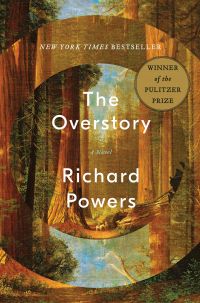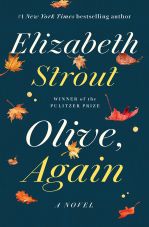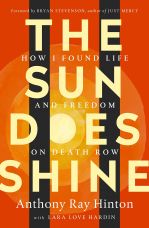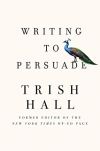What I'm Reading: November 2019
November 12, 2019 at 7:00 PM
- Asymmetry by Lisa Halliday, fiction
- Fates and Furies by Lauren Groff, fiction
- What You Have Heard Is True: A Memoir of Witness and Resistance by Carolyn Forché, memoir
- Troublemakers: Lessons in Freedom from Young Children At School by Carla Shalaby, nonfiction, professional
- Teach Me, Teacher by Jacob Chastain, professional; personal stories, advice
- Normal People by Sally Rooney, fiction
- The Overstory by Richard Powers, fiction
- We Got This: Equity, Access, and the Quest to Be Who Our Students Need Us to Be by Cornelius Minor, professional
- Working Hard, Working Happy: Cultivating a Culture of Effort and Joy in the Classroom by Rita Platt, professional
- The Source of Self-Regard: Selected Essays, Speeches, and Meditations by Toni Morrison, essays
- Writing to Persuade by Trish Hall, writing, professional
- Horizon by Barry Lopez, environmental nonfiction
- The Last Ocean: A Journey Through Memory and Forgetting by Nicci Gerrard, nonfiction/investigation
- How to Be an Antiracist by Ibram X. Kendi, racial justice, nonfiction
- Bolder: Making the Most of Our Longer Lives by Carl Honoré, nonfiction, guide
- The Education of an Idealist: A Memoir by Samantha Power
- This Is How It Always Is by Laurie Frankel, fiction
- The Knowledge Gap: The Hidden Cause of America’s Broken Education System—And How to Fix it by Natalie Wexler, educational journalism, nonfiction
- Where the Crawdads Sing by Delia Owens, fiction
- The Sun Does Shine: How I Found Life, Freedom, and Justice by Anthony Ray Hinton, with Lara Love Hardin. nonfiction, criminal justice
- She Said: Breaking the Sexual Harassment Story That Helped Ignite a Movement by Jodi Kantor and Megan Twohey, nonfiction reporting, investigative journalism
- Red at the Bone by Jacqueline Woodson, fiction
- Olive Again by Elizabeth Strout, fiction
While I loved all of the fiction on the list, the two standouts for me are The Overstory by Richard Powers and Olive Again by Elizabeth Strout. Both books came into my sights through close friends and discerning readers--Walter Parker for the former and Toby Gordon for the latter. Their reading recommendations are always “spot on.”
 The Overstory, which won the 2019 Pulitzer Prize winner for fiction, sat on my nighttime reading table for months. I was reluctant to pick it up because of its length, a densely packed 500 pages, which felt formidable. Award-winning author and bookstore owner, Ann Patchett, calls the book "The best novel ever written about trees, and really just one of the best novels, period.” I concur. With Olive Again, once I learned that Elizabeth Strout had written a sequel to Olive Kitteridge, a book I dearly loved and which also won the Pulitzer Prize for fiction, I immediately got a copy of the book and read it straight through in two days. It was such a comfort and joy to spend more time with Olive! Both The Overstory and Olive Again are extraordinary.
The Overstory, which won the 2019 Pulitzer Prize winner for fiction, sat on my nighttime reading table for months. I was reluctant to pick it up because of its length, a densely packed 500 pages, which felt formidable. Award-winning author and bookstore owner, Ann Patchett, calls the book "The best novel ever written about trees, and really just one of the best novels, period.” I concur. With Olive Again, once I learned that Elizabeth Strout had written a sequel to Olive Kitteridge, a book I dearly loved and which also won the Pulitzer Prize for fiction, I immediately got a copy of the book and read it straight through in two days. It was such a comfort and joy to spend more time with Olive! Both The Overstory and Olive Again are extraordinary.
Here’s what you will want to know about The Overstory, which might turn out to be one of the most gorgeously written and best books you have ever read. In Ann Patchett’s endorsement, she also notes that the world Richard Powers creates alongside our own world is “...vast, slow, interconnected, resourceful, magnificently inventive, and almost invisible to us.” It is our natural world, and it is slowly disappearing. The Overstory is a gloriously written, cautionary tale focused on nine characters, who notice and act upon what’s happening to the trees on our increasingly endangered planet. That might not sound riveting, but in Power’s telling of the story, you will be amazed and captivated by the descriptions of the gifts trees provide us humans along with what the behaviors of trees can teach us. Although this is a work of fiction, all those gifts and behaviors have been “. . . studied and documented by scientists. . .” as Barbara Kingsolver notes in her outstanding, must-read review of the book at https://www.nytimes.com/2018/04/09/books/review/overstory-richard-powers.html
When possible, I prefer to read a detailed book review after I’ve read the book, but I make an exception for The Overstory. Kingsolver’s book review provides a great framework for understanding this complex story. The first 150 pages of the book fly by with fascinating tales about the nine characters, each of whom is linked to a specific tree or trees—the real protagonists of the book--and then, these human characters team up to become tree defenders who attempt to stop the destruction of our forests. If you don’t read the review, I recommend taking basic notes on these main characters, each with his/her own backstory in “Roots,” the first section of the book. In that way, you can easily refer back to the essence of each character, which will make reading the other sections of the book easier and more satisfying. This is such a sweeping and magnificent book, it’s hard to quantify it! As Kingsolver notes, “In the end, The Overstory defies its own prediction about fiction’s limits, making the contest for the world feel every bit as important as the struggles between people.”
 Moving on to Olive Again, the sequel to Olive Kitteridge, I was pleasantly surprised how Olive came into clear focus after more than a decade since I’d encountered her. Somehow, I remembered—and you will too, without going back to the original book--everything I needed to know to pick up where we last left off with unforgettable Olive. She is still ornery and irritating even as she, occasionally, performs deeds of good-heartedness. Here we encounter Olive as an older woman, still evolving into a truer version of herself as she finds a new love and tries—always with some difficulty-- to get on better with her family and with her neighbors in the small town of Crosby, Maine. Reading this book is a joy; Elizabeth Strout’s writing brilliantly shines and illuminates. Treat yourself to observing and listening in to Olive’s innermost thoughts and feelings on her past life and her emergence into a new and more self-aware life. Through the interwoven stories in Olive Again, we come to fully know Olive--with all her crankiness, humor, hope, despair, loneliness, honesty, forgiveness, and love. Olive shows us that the full human condition is possible and desirable, even through old age.
Moving on to Olive Again, the sequel to Olive Kitteridge, I was pleasantly surprised how Olive came into clear focus after more than a decade since I’d encountered her. Somehow, I remembered—and you will too, without going back to the original book--everything I needed to know to pick up where we last left off with unforgettable Olive. She is still ornery and irritating even as she, occasionally, performs deeds of good-heartedness. Here we encounter Olive as an older woman, still evolving into a truer version of herself as she finds a new love and tries—always with some difficulty-- to get on better with her family and with her neighbors in the small town of Crosby, Maine. Reading this book is a joy; Elizabeth Strout’s writing brilliantly shines and illuminates. Treat yourself to observing and listening in to Olive’s innermost thoughts and feelings on her past life and her emergence into a new and more self-aware life. Through the interwoven stories in Olive Again, we come to fully know Olive--with all her crankiness, humor, hope, despair, loneliness, honesty, forgiveness, and love. Olive shows us that the full human condition is possible and desirable, even through old age.
 In calling out the non-fiction book that most impacted me, I can’t say enough about The Sun Does Shine: How I Found Life, Freedom, and Justice by Anthony Ray Hinton. This is a remarkable and riveting story of how one courageous and righteous man-- wrongly accused and condemned to death--found forgiveness, grace, hope, and triumph against all odds. Reading this book transformed me. I came away with a heightened awareness of the unbearable suffering and horrible cruelty that mostly black and poor men endure on death row in the US; 10% of these are falsely accused of a heinous crime they did not commit. Anthony Ray Hinton spent 30 years on death row, put there by prejudiced and cruel judges, prosecutors and an inhumane justice system that deliberately and routinely ignored truth and evidence that would have exonerated him. Hinton’s eventual freedom was made possible by the unfailing, decades-long, brilliant efforts of criminal justice lawyer Bryan Stevenson, who took the case all the way to the Supreme Court. (Bryan Stevenson is the founder and head of the Equal Justice Initiative and the Innocence Project and is the author of Just Mercy. He wrote the stirring Foreword to The Sun Does Shine.) It was also the constant and big-hearted hope, compassion, and love which both Hinton’s mother and his best friend Lester unfailingly provided him that ensured his spirit, kindness, sanity, and will to live survived. Emotionally, this is a tough book to read, but I see it as required reading for all of us who truly want to understand the horror that racial bias causes and so we might become informed advocates for true justice for all.
In calling out the non-fiction book that most impacted me, I can’t say enough about The Sun Does Shine: How I Found Life, Freedom, and Justice by Anthony Ray Hinton. This is a remarkable and riveting story of how one courageous and righteous man-- wrongly accused and condemned to death--found forgiveness, grace, hope, and triumph against all odds. Reading this book transformed me. I came away with a heightened awareness of the unbearable suffering and horrible cruelty that mostly black and poor men endure on death row in the US; 10% of these are falsely accused of a heinous crime they did not commit. Anthony Ray Hinton spent 30 years on death row, put there by prejudiced and cruel judges, prosecutors and an inhumane justice system that deliberately and routinely ignored truth and evidence that would have exonerated him. Hinton’s eventual freedom was made possible by the unfailing, decades-long, brilliant efforts of criminal justice lawyer Bryan Stevenson, who took the case all the way to the Supreme Court. (Bryan Stevenson is the founder and head of the Equal Justice Initiative and the Innocence Project and is the author of Just Mercy. He wrote the stirring Foreword to The Sun Does Shine.) It was also the constant and big-hearted hope, compassion, and love which both Hinton’s mother and his best friend Lester unfailingly provided him that ensured his spirit, kindness, sanity, and will to live survived. Emotionally, this is a tough book to read, but I see it as required reading for all of us who truly want to understand the horror that racial bias causes and so we might become informed advocates for true justice for all.
 Finally, about a quarter of the books I read over the past six months are professional ones. While all of those on the list are excellent, Matt Renwick, esteemed colleague and friend, kindly gifted me the one that most personally affected me. The book is Writing To Persuade by Trish Hall, former editor of The New York Times Op-Ed page, and it’s one of the best books I’ve ever read for communicating persuasively, personally, and credibly. Full of great stories, tips, advice, and practical guidance, this book will make you a better writer and teacher of writing. It’s a great read that will leave you feeling more competent and confident about how to persuade your reader. Hall’s advice also applies to speaking to persuade.
Finally, about a quarter of the books I read over the past six months are professional ones. While all of those on the list are excellent, Matt Renwick, esteemed colleague and friend, kindly gifted me the one that most personally affected me. The book is Writing To Persuade by Trish Hall, former editor of The New York Times Op-Ed page, and it’s one of the best books I’ve ever read for communicating persuasively, personally, and credibly. Full of great stories, tips, advice, and practical guidance, this book will make you a better writer and teacher of writing. It’s a great read that will leave you feeling more competent and confident about how to persuade your reader. Hall’s advice also applies to speaking to persuade.
Commentary: The Necessary Human Component in Becoming a Reader
I did not become a reader until I was a teenager. By that I mean I did not choose to read as an enjoyable pastime. I learned how to read in school without difficulty. I could easily decode words and read with fluency, but I didn’t have interest in seeking out books for pleasure, for learning more about a chosen subject, or for challenging my thinking. Reading was a school thing that was assigned, a chore to be completed.
I went on to become a teacher of reading as an elementary school teacher and, later, as a specialist who taught students one-on-one and in small groups. At first, that teaching exclusively focused on phonics, as that was my main educational “training” in college and which remained my core emphasis for decades. But later that “training” also included becoming a certified reading specialist, a certified teacher of children with learning disabilities (including children with dyslexia), and a certified Reading Recovery teacher. Not to be minimized was my on-the-ground “training” as a parent who read aloud, valued a rich home library, regularly visited and signed out books from the public library and who, as an avid reader, routinely talked about favorite books informally with friends and more formally in book clubs. So my education in teaching reading has been multi-faceted. It cannot be reduced to one right way or just a scientific view of teaching reading. It is specific, explicit, eclectic, and personal—all at the same time. And the human variable is paramount. The reader’s interests, life experiences, strengths, and weaknesses are all taken into account along with the scientific research and the craft of teaching readers.
What often gets left out in the never-ending reading debate is that we teach readers, not just reading. As a lifelong reading teacher I have never failed to teach a child to read. And that wasn’t just because I was great at teaching phonics and skills. I did know every phonics rule, every onset and rime, every word pattern and how to teach them and in what prescribed order—but getting kids to decode was just the necessary beginning. When students were most successful at becoming comprehending readers who loved to read, I also used kids’ interests as I was teaching them how to read. If a student loved horses, then I found books about horses and read them aloud, we read together, listened to and followed along, or wrote our own books—sounding out the words aloud as I was writing them, and then reading those words and sentences together. When possible, I had an accomplished, peer-student-reader voluntarily take on some of that work. That all worked well because the classroom culture was one of high trust and respect for all learners. There were no “leveled readers”, just children learning to become readers.
What concerns me these days is that the reading debate is so polarized, and also rarely is an actual reader-- a human being with deep emotions, preferences, strengths, and needs—mentioned as part of the conversation. Take dyslexia, for example. With good reason, parents of children who have dyslexia are angry when their children have failed to learn to read in school. And, as we often do in education, when something isn’t working we go to an opposite extreme to “fix it.” Today that has come to mean testing all children, starting in kindergarten, and” training” all teachers to teach these students—even though in my decades of experience, the number of children with dyslexia is a very small, about 2-3% of the population. I worry that the present dyslexia debate is too narrowly focused on the science of reading without also including the craft of reading and developing children who not just can read but who want to read. Recently I wrote the following paragraph (published @readbyexample), when I was asked to briefly write about one or two things that are important for educators, parents and students to know about dyslexia. I deliberately chose to focus on the human side of learning to read—to balance out the national conversation on this topic.
While dyslexia is a specific reading disability that requires explicit and highly knowledgeable teaching in order to learn to read, too often the label and diagnosis are used to define and limit a learner’s possibilities. It’s vital that teachers, leaders, parents, and students raise their expectations for what’s possible! Some of the most imaginative, brilliant, and highly successful people who have ever lived are believed to have had dyslexia, for example, Steve Jobs, Thomas Edison, Leonardo da Vinci, Steven Spielberg, John Lennon, and Jamie Oliver, to name several. Share those luminaries’ life stories, and help students with dyslexia find and follow their own passions and talents. Those passions will help fuel learners’ hunger and need to know so they can find unique expression for their inspired thoughts and ideas-- beyond reading and writing-- through music, the visual and performing arts, inventions, cooking, and other creative means.
Time and time again, I have found that it’s finding out what a student is passionate about that unleashes that child’s potential to become a reader, not just someone who can read but a curious, responsible person and citizen who chooses to read for pleasure, information, and becoming more fully human. As an example, I’ll never forget working with a group of four, fifth grade boys who were deemed to be two to three years below grade level in reading, according to standardized test scores and their classroom teacher’s assessment. In talking with the students about their interests, I learned they were upset about the way the playground worked at recess. They felt some rules and procedures were burdensome and unfair. So I suggested we write a text together, detailing what was “wrong” and offering specific suggestions for improvement. We discussed what form the text would take and who our audience would be—the principal, teachers at the school, and other students. We did a shared writing, where I acted as scribe, holding the pen and helping them shape their ideas and thinking, as I did the actual transcription. From that draft text we authored and revised together, and using their text I taught them the word solving and phonics skills they had never mastered. We—and each of them alone or with a partner-- read and reread that text together until they could fluently read it. Because they would be going classroom to classroom (their idea) to read their call-to-action text, they were motivated to practice and reread their text over and over again until that reading was seamless. It was the competence and confidence from that successful experience that finally propelled these boys into seeking out the reading and writing life as a humane and human endeavor—and, ultimately, a pleasurable one.